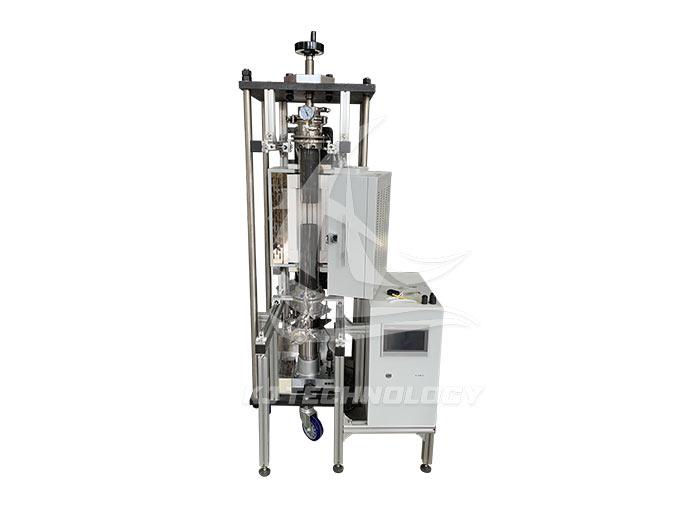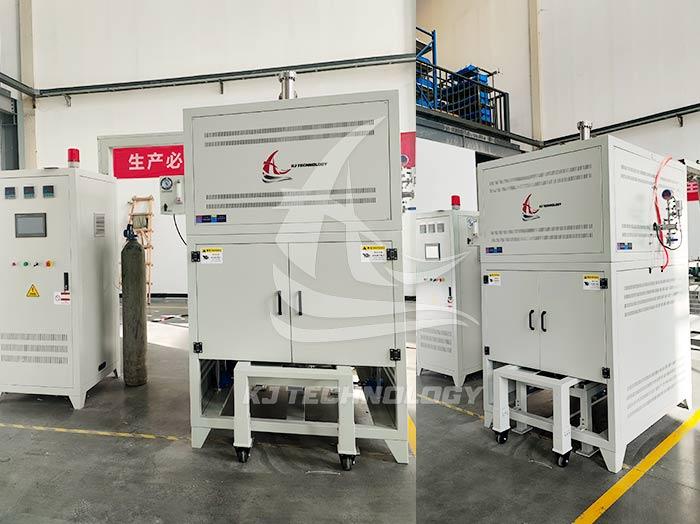Diffusion welding vacuum furnace
 08-18-2025 Author: KJ technology
08-18-2025 Author: KJ technology
Diffusion welding vacuum furnace (vacuum diffusion welding furnace) is a specialized equipment that forms metallurgical connections by diffusing atoms at the contact surface of materials through high-temperature pressure under vacuum or protective atmosphere conditions. The following provides a detailed introduction from the aspects of equipment principle, structural composition, technical characteristics, application fields, and operational precautions:
Equipment Principle
The vacuum diffusion welding furnace achieves tight bonding between different materials such as metals and ceramics by controlling temperature and pressure. Its working principle is mainly based on the diffusion behavior of materials in high temperature and high pressure environments:
In the furnace, the workpiece to be welded is heated to high temperature and maintained at a certain pressure for a period of time.
During this process, oxides and other impurities on the surface of the workpiece are removed, and pure metal atoms diffuse and come into contact with each other at high temperatures, ultimately forming metallurgical bonds. This bonding strength is much higher than mechanical clamping or simple physical contact, and can achieve efficient and high-strength connections between workpieces.
structural composition
A vacuum diffusion welding furnace typically consists of the following core systems:
Furnace body: provides the vacuum or protective atmosphere environment required for welding, usually equipped with observation windows, furnace doors, and other components for easy operation and observation.
Heating system: using resistance heating, induction heating and other methods to provide the required high-temperature environment for the welding process. Heating systems usually have multi zone independent temperature control functions to ensure temperature uniformity inside the furnace.
Temperature measurement system: Real time monitoring of the temperature inside the furnace to ensure that the welding process is carried out under precise temperature control. Temperature measurement systems usually use temperature measuring elements such as thermocouples, which have high precision and stability.
Pressure system: Apply pressure to the workpiece during the welding process to promote atomic diffusion and metallurgical bonding. Pressure systems are usually equipped with displacement sensors and other components to monitor welding deformation in real time and ensure welding quality.
Vacuum system: composed of vacuum pump, vacuum valve, vacuum gauge and other components, responsible for pumping the furnace to a high vacuum state to meet the welding process requirements.
Technical Features
As a core equipment in the high-end manufacturing field, the vacuum diffusion welding furnace has the following product advantages:
High precision temperature pressure collaborative control: adopting multi zone independent temperature control technology and high-precision pressure loading system to ensure uniform atomic diffusion at the welding interface and reduce thermal stress. The temperature uniformity inside the furnace can reach ± 3 ℃, and the pressure accuracy is ≤± 0.5%.
Material compatibility and process adaptability: It can connect various materials such as metal metal (such as titanium/steel), metal ceramic (such as tungsten/alumina), metal non-metal (such as carbon fiber composite materials), etc., breaking through the limitations of traditional welding. Simultaneously supporting complex structural processing capabilities such as multi-layer welding and flexible clamping of irregular workpieces.
Efficient, energy-saving, and intelligent: equipped with a circulating cooling system to shorten the process cycle, suppress grain coarsening, and improve production efficiency. Adopting PLC+touch screen+integrated control system, supporting multi-stage process programming, real-time monitoring of temperature, pressure, vacuum degree and other parameters, automatic data storage and traceability. In addition, the use of efficient insulation materials significantly reduces energy consumption, with an energy-saving effect of over 30%.
High reliability and safety: The cold state ultimate vacuum degree reaches 5.0 × 10 ⁻⁴ Pa, and the special sealing structure ensures long-term use without leakage. The pressure head adopts TZM alloy or isostatic pressed graphite, with flatness controlled within 0.05mm, and optimized through 3D finite element simulation to ensure no trace deformation under high temperature and high pressure.
Application field
Vacuum diffusion welding furnace plays an irreplaceable role in aerospace, nuclear industry, power electronics and other fields, with a wide range of applications including but not limited to the following aspects:
Aerospace field: used for welding key components such as aircraft engine blades, turbine disks, combustion chambers, as well as connecting structural components of satellites, rockets, and other spacecraft.
In the field of nuclear industry: used for welding key equipment such as pressure vessels, steam generators, and main pipelines in nuclear reactors to ensure the safe operation of nuclear facilities.
In the field of power electronics, it is used for welding high-voltage switches, transformers, capacitors and other power equipment to improve the reliability and service life of the equipment.
Other fields: It can also be used for high-precision welding needs in automotive manufacturing, shipbuilding industry, medical equipment and other fields.
Precautions for operation
When using a vacuum diffusion welding furnace, the following precautions should be taken to ensure safety and welding quality:
Pre homework inspection: Check that there is no electrical leakage in the body shell; Connect the steering switch of the control circuit and the small switch of the welding current, adjust the welding parameters to meet the process requirements; Check for any electrical leakage in the electrical equipment, operating mechanism, and body casing.
Safety protection: Welding operators and collaborators must wear labor protection equipment according to regulations, and must take safety measures to prevent accidents such as electric shock, falling from heights, and fires. Welding machines used outdoors should be equipped with rain, moisture, and sun shelters, and corresponding fire-fighting equipment should be installed.
Operation specifications: The upper and lower welding parts should be held firmly, and both hands should maintain a certain distance from the electrodes. Fingers should not be placed between the two welding parts to avoid burns; Avoid severe vibration or impact on equipment during the welding process; Pay attention to controlling the vacuum pumping speed to avoid material fracture or deformation caused by excessive vacuum pumping.
Post operation maintenance: After the work is completed, turn off the heating system, gas protection system, vacuum system, and pressurization system before turning off the main power supply; Regularly clean the inside of the furnace and the outside of the equipment to keep it clean; Check and replace vulnerable parts such as sealing rings to ensure the sealing performance of the equipment; Record operational data and equipment status for subsequent analysis and improvement.








